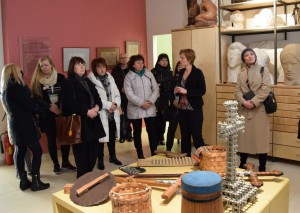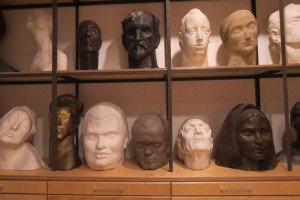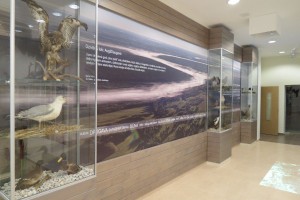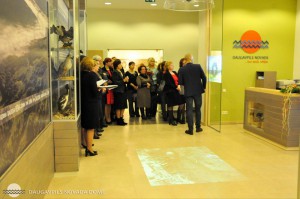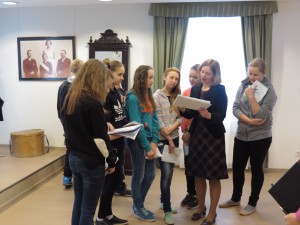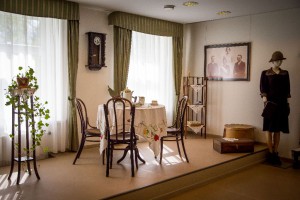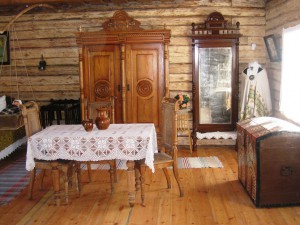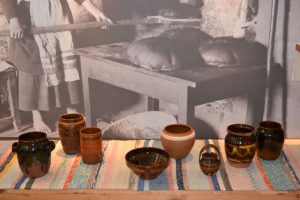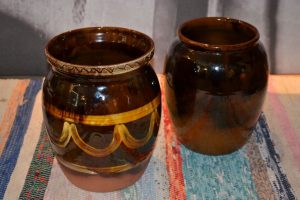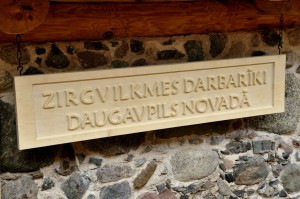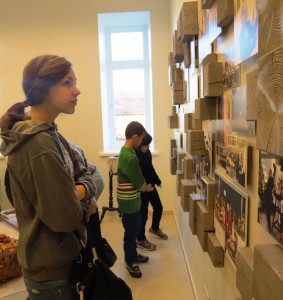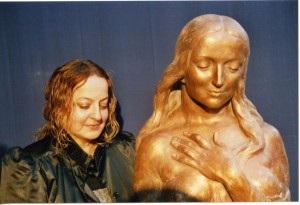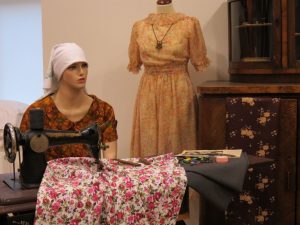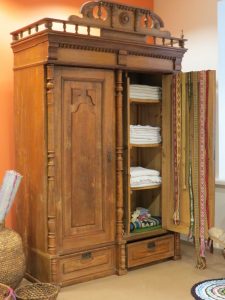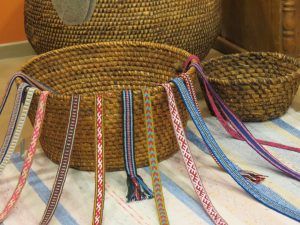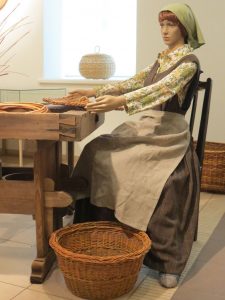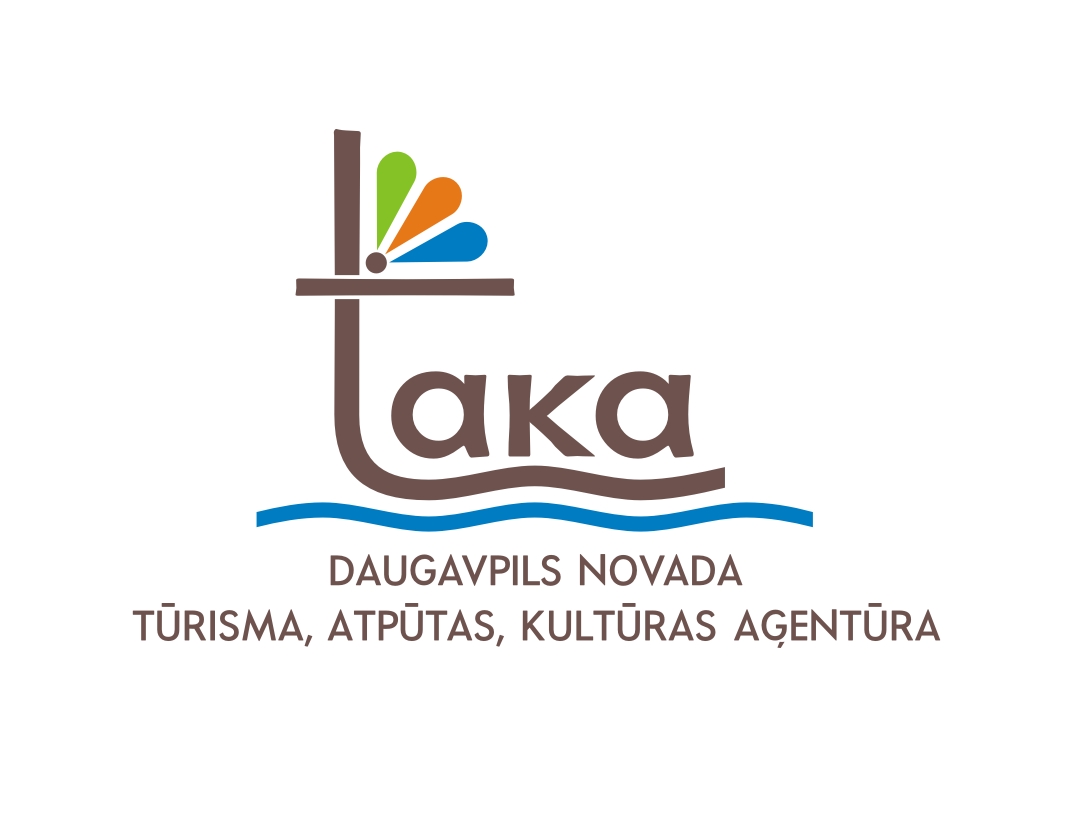PERMANENT EXPOSITIONS
ART EXPOSITION „VALENTINA ZEILE – PARISIAN FROM LATGALE”
Living near the picturesque Daugava valley, in the native „Jaunkausini” house built by Valentina`s Zeile father, sculptress from childhood felt in love with art. And this all thanks to her father Antonijs Zeile, who leisure moments dealt with woodcarving. Native side nature also has inspired the sculptress. From meadows and lush verdure of rye fields, Valentina took over the richness of colours, from Latgale loamy land – tenacity and perseverance. It all reflects in pastels depicting native home, parents Antonijs and Anele Zeile and beloved banks of the Daugava river. Valentina life and creative work, like charming meanders of Daugava river valley, thrown two circles, the first of which was rooted and gained strength in Latgale, Naujene, but ended in Riga. In turn, the second enticed sculptress to her dreamland – France, Paris, where she has been living for over 30 years.
In the exhibition are viewable works of art in bronze, in which especially brightly expressed talent facets of the sculptress Valentina Zeile. Most of the exhibits consist of the medals and plaquettes because sculptress is considered as the leading medal artist in the former Soviet Union. In the 4 showcases, visitors can see the medal series, which are devoted to the family, relatives, doctors, teachers, poets and prominent public figures. The travel impressions reflected in the medal cycles dedicated to the Czech Republic, France and Asia. Attract the attention the number of the artist’s self-portraits.
The travel impressions of Africa is reflected in the sculpture cycle dedicated to this country. 4 works of art of the cycle are viewable in the exhibition: „The strength of generations”, „The rhythms of Gambia”, „The joy of living” and „Sculptor Paul Ai from Togo”. Also, the breeze of France is felt in the exhibition. The sculpture “The man and a horse” is a tribute to Bartabas [born Clément Marty] – Zingaro horse theatre founder in Paris suburb at Aubervilliers. While the sculpture “Skater” gained prominence not only in Latvian – one copy of the work of art is located in the gallery in Athens [Greece]
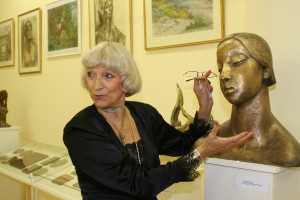
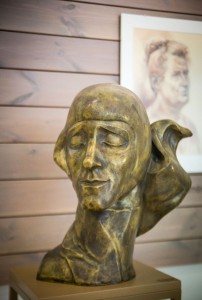
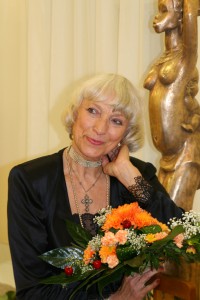
WORKSHOP OF VALENTINA ZEILE / DONATION OF PAINTER GERTRUDA ZEILE
Once Valentina Zeile gave the promise: wherever she would not live, she will always come back to her hometown with her works of art. The promise fulfilled in public collection store – room „Workshop of Valentina Zeile” where can be viewed and stored unexposed part of Valentina Zeile collection. The collection consists of more than 6200 items, which are mainly created before sculptress departure to Paris [1956-1982]. Workshop of Valentina Zeile designed as a public collection store – room that reflects the artist’s creative life in Vecdaugava [Riga, Latvia].
Remembering this period of life the sculptress in her book „Valentina” wrote: „In Vecdaugava house, built by my daddy, I spent long, happy and corny years of my life. My best works of art created there. I was happy there, I felt like a queen in her palace. I organized parties and carnivals, my friends, artists, actors, scientists came to me. Actors posed for me: neighbour Karlis Sebris, funny Rudolfs Plepis and very serious Juris Strenga, who posed, without missing book out of his hands. Even today in the ears sound silvery voice of the Riga Russian Drama Theatre excellent actor Mikhail Hiznakov, – until the morning light he used to recite texts from that time performances – “Man of La Mancha” and “Conversations with Socrates.” Unforgettable moments left in memory also with other theatre stars, creating their portraits – always cozy tea drinking with the scene queen Elsa Radzina … ”
In 2016 Naujene Local History museum collection was supplemented with painter Gertrude Zeile donation – objects owned by Zeile family: mother Anele Zeile handicrafts [doily, gloves] and objects manufactured by father Antonijs Zeile and used in everyday life [table, baskets, plane, hammer, wooden bowl, and washing board with the dolly]. Each object, as a witness of those times, shows opportunities and lifestyle, providing a brief look in “Jaunkaushini” house everyday life. In exhibition also represented crosses and crucifixes made by Antonijs Zeile for St. Peter and Paul Roman Catholic Juzefova church.
NATURE EXPOSITION „SIRDSDAUGAVA”
The exhibition represents the protected area of unique Augšdaugava landscape territory and nature park „Daugavas Loki”. Nature park was created to preserve the unique natural complexes, natural, cultural and historical values and little – transformed landscapes of the ancient valley of the Daugava on the site of Naujene to Kraslava. The bends of the ancient valley of the Daugava are considered to be the oldest geological formations in Latvia. The nature park as part of Augsdaugava protected landscapes area was recognized as the NATURA 2000 territory in 2004, but in 2011 this park was included in the Latvian National UNESCO World Heritage List. The River Daugava is a structural axis for the nature park, forming picturesque bends. There are picturesque landscapes from the banks of the river. Since ancient times the River Daugava was the main element of the development of this area – water trade route. Castles and villages were built on the banks of the river. An ancient but eternally young Daugava with its apparent calm watercourse had been conducting a titanic effort, for thousands of years creating a unique valley that produces an unforgettable impression on each traveller. Visitors can use various multimedia solutions for more information such as floor interactive projection with sound shower to listen to sounds of nature, as well as Led display for more information about Daugavpils hydropower station history or holocube.
HISTORY EXPOSITION „POLISH CULTURE HERITAGE IN DAUGAVPILS REGION”
Daugavpils region cultural environment, determined by the historical process, has formed ethnically diverse and one of the largest minorities are Poles. The Poles settled in Latvia after the collapse of Livonia in 1562, when Latgale was included in the Polish – Lithuanian state. As a part of Polish – Lithuanian state, Latgale strengthened Catholicism, but Polish manors became the cultural centres.
The insight of Polish manor houses in Daugavpils region can be represented by Juzefova [Polish:Jozefow] manor plans. Juzefova manor started to develop in the 17th century. In 1900 – 1901 Polish landlord Bogdan Shahno built a new manor house in the neoclassical style by Baltic German architect Wilhelm Neumann [German: Johann Wilhelm Carl Neumann] project. During World War II in 1942 Juzefova manor house was burned down.
The exhibition consists of household items that characterize the Polish culture, fashion and traditions in the second half of 19th century and the first half of the 20th century. Furniture, Kuznetsov Porcelain Factory dishes and fine embroidery, compositionally reflect the living room interior of the first half of the 20th century. The main part of the exhibits consists of Naujene children`s home donated collection, as well as Daugavpils region inhabitants donations. Juzefova manor everyday life story is recorded from Anna Ratkevicha memories – the nanny of landlord daughter Maria. In the exhibition represented the authentic nanny`s dress with Richelieu embroidery preserved until nowadays.
ETHNOGRAPHIC EXPOSITION “WEALTHY PEASANT ROOM”
[the end of the 19th century – the first half of the 20th century]Peasant houses in Latgale were built from pine or fir logs. The buildings consisted of 10-12 log wreaths, among which led dried moss. Sawn plank floors in houses up to the 19th century was an unusual phenomenon typical only for some wealthy peasant farmsteads. For heat preservation in the house above the ceiling put the layer of clay, dry leaves or flax.
The exposition consists of household objects and tools that characterize Latgale wealthy farmer’s home interior, lifestyle, traditions and culture in Naujene parish at the end of the 19th century and the first half of the 20th century.
ETHNOGRAPHIC EXPOSITION “POTTERY TRADITIONS IN DAUGAVPILS REGION”
Pottery in Latvia was developed mainly in two regions – Latgale and Kurzeme. However, only in Latgale it has survived to the present days and forms one of the brightest features of traditional culture, which is included in the Latvian culture canon. Pottery was practiced in areas rich with “gold of Latgale” – clay and firewood. There was a great demand for household clay utensil, so this craft industry became a profitable source of income for peasant to maintain their large family. Initially, women were engaged in making utensil by firing them in household fireplaces. In Naujene parish, under the foundations of the Livonian Order Dinaburg castle, in the pre – German cultural layer, fragments of clay utensil with a scratched, smooth and plastered surface have been found. In the Х century began to introduce the potter’s wheel and pottery became a craft for men. Pottery centers were formed, in which potters worked for several generations, transferring their job skills from father or neighbour. Over time improved the technology of making utensil as well as types and shapes of utensil. Appeared ornaments and glaze. The pattern of straight and zigzag lines became popular, which was drawn by rotating the pot on the potter’s wheel.
In the ХIII-XVI centuries, household utensils were made in settlements near the Dinaburg castle and in the ancient town. Later, pottery was practiced in the villages belonging to Juzefova manor. In 1883, there were 13 potters and 2 apprentices in pottery in Daugavpils district. The number of potters in the district gradually increased every year. During Latvia’s independence, pottery was promoted by Latvian Chamber of Crafts by various pottery courses. After the Second World War, the Soviet government tried to eliminate individual production in crafts as well. The potter’s work was heavily taxed and considered parasitic. Therefore, potters’ workshops and kilns were soon stamped, and the property was described.
In Daugavpils city and region, the rebirth of ceramics as a folk art was achieved only at the end of the 1950s, when Staņislavs Vilcāns, a famous representative of the traditional Silajāņi pottery, moved to the city. In Soviet times, the only ceramic kiln in Daugavpils district was located at Kokini, in the collective farm “Znamja Oktjabrja” in the village of Malinovka. In this workshop worked 2 masters of Folk Arts – Vladislavs Vincevičs and Staņislavs Vilcāns junior. At the beginning of the 3rd Awakening, Vladislavs Vincevičs bought a former collective farm horse stable and continues to develop the pottery traditions of Daugavpils region nowadays together with his son Edvīns Vincevičs.
Pottery of Latgale is characterized by two development lines – practical and decorative. The practical pottery was developed over several thousand years, making the utensils for farmstead needs. The exposition is characterized by such household utensils as pots for cooking and food storage, milk, honey and jam pots, bowls, cups and mugs. Decorative pottery or “making ceramics” came into use at the beginning of the XX century. The brightest examples in the exhibition are candlesticks, whistles [clay whistles in the form of an animal, bird, or mythical creature], vases, beer mugs, salt shakers, vases and flower pots.
The exposition represents household utensils made by Latgalian potters from the end of the XIX century – the first half of the XX century, which were purchased by the residents of Naujene Parish at fairs in Juzefova, Višķi, Izvala or from travelling merchants, as well as the authorworks of the grandmaster Andrejs Paulāns and potters Valdis Pauliņš, Lilija Zeiļa, Juris Krompāns and Voldemārs Voguls, who are well – known in Latgale today.
ETHNOGRAPHIC EXPOSITION „SLUTIŠĶI OLD-BELIEVERS’ FARMSTEAD”
Slutišķi Old-believers’ farmstead is made of two expositions: „Old-believers’ dwelling house” and „Horse-powered traction tools in Daugavpils district”. The exposition buildings were renewed in 2015 within the project “Old-believers’ historical construction restoration and preservation of agricultural cultural and historical heritage in Slutišķi Village” supported by the European Agricultural Fund for Rural Development (EAFRD).
The exposition „Old-believers’ dwelling house” is located in a building that was built in the beginning of the 20th century, which preserves the traditional Old-believers’ house planning: entering the door, a visitor gets into narrow cold hallway. To the right from the hallway, the house’s residential part is located – it is a room, in which we see the “red” (God’s Holy Corner) corner and the “black” corner or women corner and the room’s part, which was used for sleeping. In the left part of the room, there is a brick stove – the so-called Russian stove.
On the left side of the cold hallways, there is a barn and a mill. In the barn or the “cold room”, there used to be a table covered with embroidered towels – rušņiki, on which there was a bread baked for the week; at the wall – a wardrobe and a bed. Currently, the “cold room” keeps a loom, which the old-believers used to use only in winter.
At the „cold end”, there was a flour-mill, where not only flour was milled with handmill, but products were kept there as well. The flour mill served as the storeroom – in winter, lard salted in tubs was kept here, in its turn, in summer, the tools (loom, carriage) not used in household at that moment were kept here.
The exposition „Horse-powered traction tools in Daugavpils district ” is arranged in the renovated household buildings – cattle shed and barn. Museum articles, mostly horse-powered traction tools, which refer to the 1st part of the 20th century and are used in Daugavpils County’s territory, which are connected with agriculture and farming, can be viewed in it.
At the turn of the 19th and the 20th century in Latgale, small households were dominating. Many farmers produced in their farms almost all products necessary for their family maintenance and made a considerable part of tools, including the simplest vehicles (sleighs, work carts – dray carts etc.). While the driving carts, droshky, sledges and other more complex vehicles and their parts (bent slides, wheels, wheel arcs etc.) were made by craftsmen.
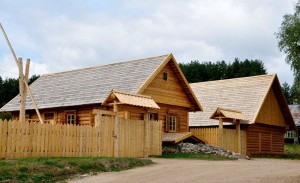
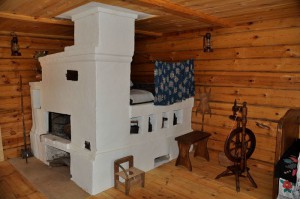
EXHIBITIONS
EXHIBITION „FAMILY HERITAGE”
The photo story about the unique Zeile family. 2 talented artists – Valentine and Gertrude Zeile was brought up and educated in the ordinary peasant family. Exhibition visitors address photos of the beginning of the 20th century that show the two sisters father Anthonijs Zeile with his mother Magdalene Zeile at the native home at the “Mazie Lachi” in Izvalta. From other photos of the 1930s look at as Valentina’s and Gertrude`s mother Anele Kokina. In many pictures appears small Valentina with sister Gertrude, parents Antonijs and Anele Zeile in the native village in Vilushi. In rare scenes immortalized grandfather Adams Kokins and grandfather’s wife’s sister Victoria Surmacha. Sculptress Valentina Zeile called Victoria „my grandmother” and devoted her one of the first work of arts with the same name “Grandmother”.
EXHIBITION FROM THE CYCLE “A TRIBUTE TO THE LIFE OF CHRIST”
CHRIST IS THE ONLY OUR LAND TEACHER /VALENTINA ZEILE/
The thematic Valentina Zeile sculpture exhibition from museum collection store “THE CONVERSATION” displaying sculpture cycle “A TRIBUTE TO THE LIFE OF CHRIST”. The cycle consists of 8 sculpture dedicated to the religious theme. 6 of them are represented in the exhibition, but 2 works of art – „Adam” and „Ieva” are located in sculptress collection. The first sculpture of the cycle “The Message” was created as a thank to Our Lady for the opportunity to move to Paris and to all who so generously have been given to the sculptress, particularly for her ability to express themselves in art.
“Since 1971, when I the first time landed in Paris – a city whose symbol is the Cathedral of Our Lady – all subsequent ten painful nostalgia opulent years until I moved to France, I desperately praying Her:” Take me to your city!” And later, when it had happened, I wrote a letter of thanks to Our Lady and undertook to create her image – when I will be ready – and donate it to Paris.”/ Valentina Zeile /
EXHIBITION “HANDICRAFT TRADITIONS IN DAUGAVA RIVER VALLEY TERRITORY”
The Gatherings or „suprātkas” as they are called in Latgale is an ancient household tradition where people used to gather in the evenings and work together as well as relax. These were mostly quiet meetings filled with storytelling, but sometimes it was a fun way of spending time – dancing, singing and playing games. At these gatherings, women and young girls used to do their chores – knit, wove, crochet and sew. Therefore „suprātkas” were known as evenings where women made different items to fill their dowry chests with in preparation for marriage. The exhibition presents a small part of such traditional bridal dowry made by local handicrafters.
The honour and pride of a Latgalian woman is the woven blankets, tablecloths, belts and knitted patterned gloves and socks. The significance of traditional handicrafts in the Latgalian farmstead daily life and in festivity is reflected in this exhibition.
White linen towels symbolized the world as a whole. They were widely used in everyday life and feasts. Towels were hanged in the place of honour or used under the served festive food. The most popular and widespread towel decoration at the end of the 19th century were monograms embroidered with red threads in cross-stitch. But in the 1920s towels with multicoloured and very bright floral patterns were made in Latgale.
Latgalians adorned themselves with various belts from the cradle to the grave. It was a sign of blessing for the newborn baby, a bright decoration for the wedding and an integral part of the funeral ritual. The territory of the Daugava river valley from the 19th century until the end of World War I and in the interwar period is characterized by two kinds of belts represented in the exhibition.
Latvians worked wearing gloves (worker gloves) and used peculiarly decorated patterned gloves during the holidays and visiting the church (honorary gloves). Patterned gloves and socks were widely used in the traditional annual rituals, and it was also a beautiful gift since long ago. Gloves decorated with the traditional Latvian sign “Ūsiņš” brought success for travellers.
The “star” pattern was most widely used in honorary gloves. Maidens’ socks were luxurious and patterned, but for lads, they were simple and decorated with stripes. Men’s socks were decorated with the traditional Latvian signs “Ozoliņš” or “Aka” (“Oak” or “Well”) which gave the wearer strength and energy.
In this exhibition, the practical significance and place of handicrafts in the farmstead is demonstrated by the patterned woven bed covers and sheets as well as beautifully embroidered pillowcases. The accent of the interior of the peasant room – the bright woven carpets made of coloured rags – were covered over the whole room, creating a picturesque feeling of the overall space integrity.
The unifying element of traditional handicrafts in the exhibition is the dowry wardrobe, which symbolically depicts the woman’s work ethic, sense of beauty and the wealth of the peasant farmstead. The ambience of antiquity in the peasant farmstead during “The gatherings” is created via the exhibition’s virtual part – the songs of the local Naujene folklore group “Rūžēņa” and the visualization of the scenes from the rural life and old crafts in Latgale farmsteads in 1927 photographs.

